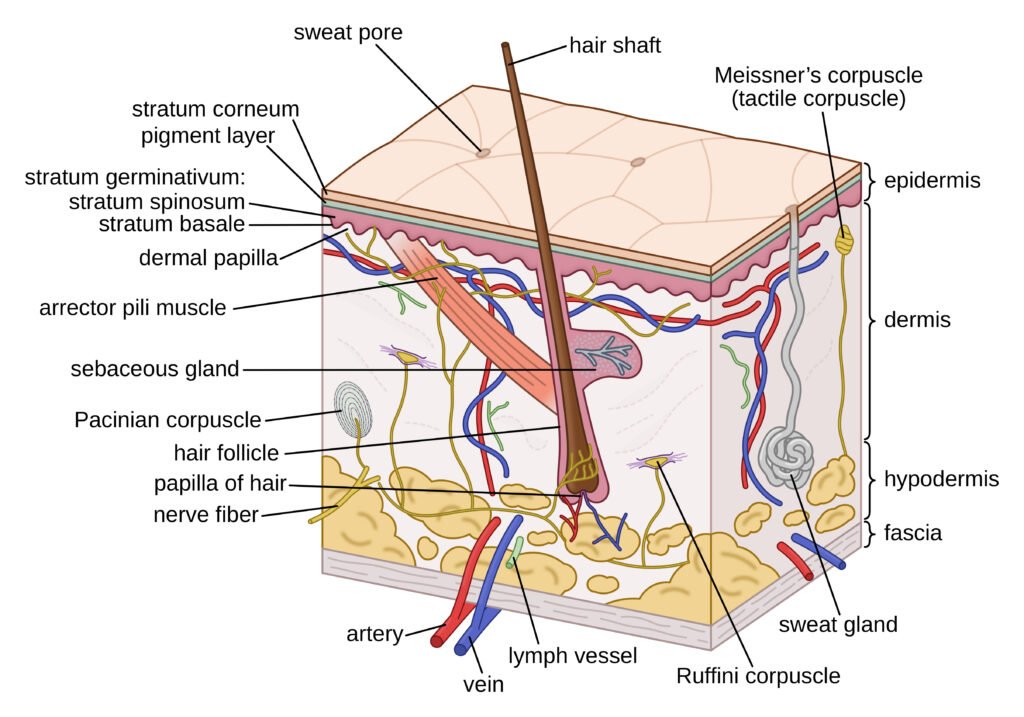The integumentary system, comprising the skin, hair, nails, and glands, is the body’s largest organ system and serves as the primary barrier between our internal structures and the external environment. Although it plays a vital role in protecting us, the integumentary system is not immune to diseases, disorders, and injuries. This article explores the various ailments that can affect this system, offering insights into their causes, symptoms, and potential treatments.
Diseases, Disorders, and Injuries of the Integumentary System

Understanding the Integumentary System
Before diving into the details of specific ailments, it’s essential to understand the primary components and functions of the integumentary system:
- Skin: This multi-layered structure protects our internal organs, regulates body temperature, and enables the sense of touch. It comprises three main layers:
- Epidermis: The outermost layer, which is responsible for producing new skin cells and giving skin its color.
- Dermis: Contains blood vessels, nerves, and hair follicles. It’s where sweat and sebaceous (oil) glands reside.
- Subcutaneous layer: Consists of fat and connective tissues that insulate and cushion the body.
- Hair: Not just a cosmetic feature, hair provides protection, regulates body temperature, and facilitates the sense of touch.
- Nails: Protect the fingertips and toes, while also assisting in the sensation of touch.
- Glands: Produce sweat and oils, helping in thermoregulation and protection against microbial invaders.
Common Diseases and Disorders
Acne
- Description: Acne is a common skin condition that arises when hair follicles become clogged with oil and dead skin cells. It usually appears on the face, chest, back, and shoulders.
- Causes: Hormonal changes, diet, stress, and certain medications.
- Symptoms: Whiteheads, blackheads, pimples, cysts, and nodules.
- Treatments: Over-the-counter creams, prescription medications, and in some cases, light therapy or drainage procedures.
Eczema (Atopic Dermatitis)
- Description: A chronic inflammatory skin condition characterized by itchy, inflamed skin.
- Causes: A combination of genetics, environment, and an overactive immune system.
- Symptoms: Red, itchy rashes, often on the hands, feet, or inside the bends of the elbows or knees.
- Treatments: Moisturizers, corticosteroid creams, and oral antihistamines.
Psoriasis
- Description: A chronic autoimmune condition causing cells to build up rapidly on the skin’s surface.
- Causes: Genetic predisposition and environmental triggers.
- Symptoms: Red patches with silvery scales, itching, burning.
- Treatments: Topical treatments, light therapy, and systemic medications.
Rosacea
- Description: A chronic skin condition causing redness and visible blood vessels in the face.
- Causes: Unknown, but potential factors include heredity, blood vessel issues, and skin mites.
- Symptoms: Redness on the nose, cheeks, chin, and forehead, swollen red bumps, and visible blood vessels.
- Treatments: Topical drugs, oral medications, and laser therapy.
Vitiligo
- Description: A condition where skin loses its pigment in patches.
- Causes: The body’s immune system attacking and destroying melanocytes in the skin.
- Symptoms: White patches on the skin, premature hair whitening.
- Treatments: Medications, light therapies, and skin grafting.
Melanoma
- Description: The most severe type of skin cancer, originating in the skin’s melanocytes.
- Causes: DNA damage from UV exposure, genetic predisposition.
- Symptoms: Moles that change in size, shape, or color; new skin growths.
- Treatments: Surgical removal, chemotherapy, radiation therapy.
Injuries of the Integumentary System
Burns
Burns are categorized by their severity:
- First-degree burns: Only affect the epidermis, causing redness and pain.
- Second-degree burns: Affect both the epidermis and dermis, causing redness, pain, swelling, and blisters.
- Third-degree burns: Reach the subcutaneous layer, appearing white or charred.
- Treatments: Cooling the burn, pain relief, topical treatments, and in severe cases, skin grafting.
Cuts and Lacerations
- Description: A break or opening in the skin.
- Treatments: Cleaning the wound, using antiseptics, and in some cases, sutures or stitches.
Pressure Ulcers
- Description: Also known as bedsores, these are injuries to the skin and underlying tissue resulting from prolonged pressure on the skin.
- Causes: Prolonged pressure, especially in bedridden individuals.
- Treatments: Relieving pressure, cleaning, and dressing wounds, surgery in severe cases.
Prevention and Care
Maintaining the health of the integumentary system is crucial. Here are some general guidelines:
- Sun Protection: Use sunscreens, wear protective clothing, and avoid prolonged exposure during peak UV times.
- Hygiene: Regularly clean and moisturize the skin.
- Avoid Smoking: Smoking accelerates skin aging and increases the risk of skin cancer.
- Nutrition: A balanced diet rich in vitamins and minerals can support skin health.
- Regular Inspection: Check for any unusual moles or growths and consult a dermatologist when in doubt.
The integumentary system, while robust and protective, can fall victim to various diseases, disorders, and injuries. Understanding these conditions and being proactive in skincare can go a long way in ensuring our skin, hair, nails, and glands remain healthy and functional throughout our lives. Regular medical check-ups, maintaining a healthy lifestyle, and seeking timely medical advice are essential for the optimal health of our integumentary system.
